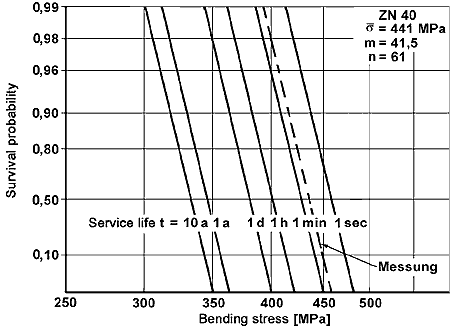5.3.4.4 Crack
Growth
A ceramic component must be designed not
only with respect to its maximum load, but also for a certain
lifetime. For this reason, knowledge of the relationship between
strength and time is necessary. Failure results as a rule
from single defects which (often) lie on or close to the surface,
since the greatest stresses usually occur there. Assuming
that the component is subjected to loads below its design
strength, and particularly if water or moist air are present
in its environment, a crack can start from a critical defect,
growing very slowly at first, then accelerating under further
load until the part finally fails. This behaviour is known
as subcritical crack propagation (stress
crack corrosion). It most often occurs in oxide ceramics,
but also in non-oxide ceramics that possess an amorphous oxide
grain boundary phase. This type of crack propagation behaviour
is well described using a method known as "linear-elastic
fracture mechanics".

Figure 88: SPT-diagram for zirconium oxide
Taking subcritical crack propagation into
account, the relationship between strength,
probability
and time can
be illustrated for a ceramic material on what is known as
an SPT-diagram.
Test procedures for determining the parameters of subcritical
crack propagation are specified in DIN EN 843-3.
|
|

